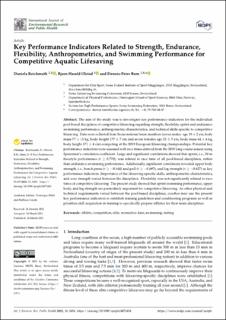Key performance indicators related to strength, endurance, flexibility, anthropometrics, and swimming performance for competitive aquatic lifesaving
| dc.contributor.author | Reichmuth, Daniela | |
| dc.contributor.author | Olstad, Bjørn Harald | |
| dc.contributor.author | Born, Dennis-Peter | |
| dc.date.accessioned | 2022-03-21T20:39:27Z | |
| dc.date.available | 2022-03-21T20:39:27Z | |
| dc.date.created | 2021-04-12T15:58:11Z | |
| dc.date.issued | 2021 | |
| dc.identifier.citation | International Journal of Environmental Research and Public Health. 2021, 18(7), Artikkel 3454. | en_US |
| dc.identifier.issn | 1661-7827 | |
| dc.identifier.uri | https://hdl.handle.net/11250/2986635 | |
| dc.description | This article is an open access article distributed under the terms and conditions of the Creative Commons Attribution (CC BY) license (https://creativecommons.org/licenses/by/4.0/). | en_US |
| dc.description.abstract | The aim of the study was to investigate key performance indicators for the individual pool-based disciplines of competitive lifesaving regarding strength, flexibility, sprint and endurance swimming performance, anthropometric characteristics, and technical skills specific to competitive lifesaving. Data were collected from Swiss national team members (seven males: age 19 ± 2 yrs, body mass 77 ± 11 kg, body height 177 ± 7 cm and seven females age 21 ± 5 yrs, body mass 64 ± 6 kg, body height 171 ± 4 cm) competing at the 2019 European lifesaving championships. Potential key performance indicators were assessed with race times derived from the 2019 long-course season using Spearman’s correlation coefficient. Large and significant correlations showed that sprint, i.e., 50 m freestyle performance (r ≥ 0.770), was related to race time of all pool-based disciplines, rather than endurance swimming performance. Additionally, significant correlations revealed upper body strength, i.e., bench press (r ≥ −0.644) and pull (r ≥ −0.697), and leg strength (r ≥ −0.627) as key performance indicators. Importance of the lifesaving-specific skills, anthropometric characteristics, and core strength varied between the disciplines. Flexibility was not significantly related to race times of competitive lifesaving. The present study showed that sprint swimming performance, upper body, and leg strength are particularly important for competitive lifesaving. As other physical and technical requirements varied between the pool-based disciplines, coaches may use the present key performance indicators to establish training guidelines and conditioning programs as well as prioritize skill acquisition in training to specifically prepare athletes for their main disciplines. | en_US |
| dc.language.iso | eng | en_US |
| dc.subject | athlete | en_US |
| dc.subject | competition | en_US |
| dc.subject | elite | en_US |
| dc.subject | normative data | en_US |
| dc.subject | swimming | en_US |
| dc.subject | testing | en_US |
| dc.title | Key performance indicators related to strength, endurance, flexibility, anthropometrics, and swimming performance for competitive aquatic lifesaving | en_US |
| dc.type | Peer reviewed | en_US |
| dc.type | Journal article | en_US |
| dc.description.version | publishedVersion | en_US |
| dc.rights.holder | © 2021 by the authors | en_US |
| dc.source.pagenumber | 12 | en_US |
| dc.source.volume | 18 | en_US |
| dc.source.journal | International Journal of Environmental Research and Public Health | en_US |
| dc.source.issue | 7 | en_US |
| dc.identifier.doi | 10.3390/ijerph18073454 | |
| dc.identifier.cristin | 1903601 | |
| dc.description.localcode | Institutt for fysisk prestasjonsevne / Department of Physical Performance | en_US |
| dc.source.articlenumber | 3454 | en_US |
| cristin.ispublished | true | |
| cristin.fulltext | original | |
| cristin.qualitycode | 1 |
Tilhørende fil(er)
Denne innførselen finnes i følgende samling(er)
-
Artikler / Articles [2119]
-
Publikasjoner fra Cristin [1107]
